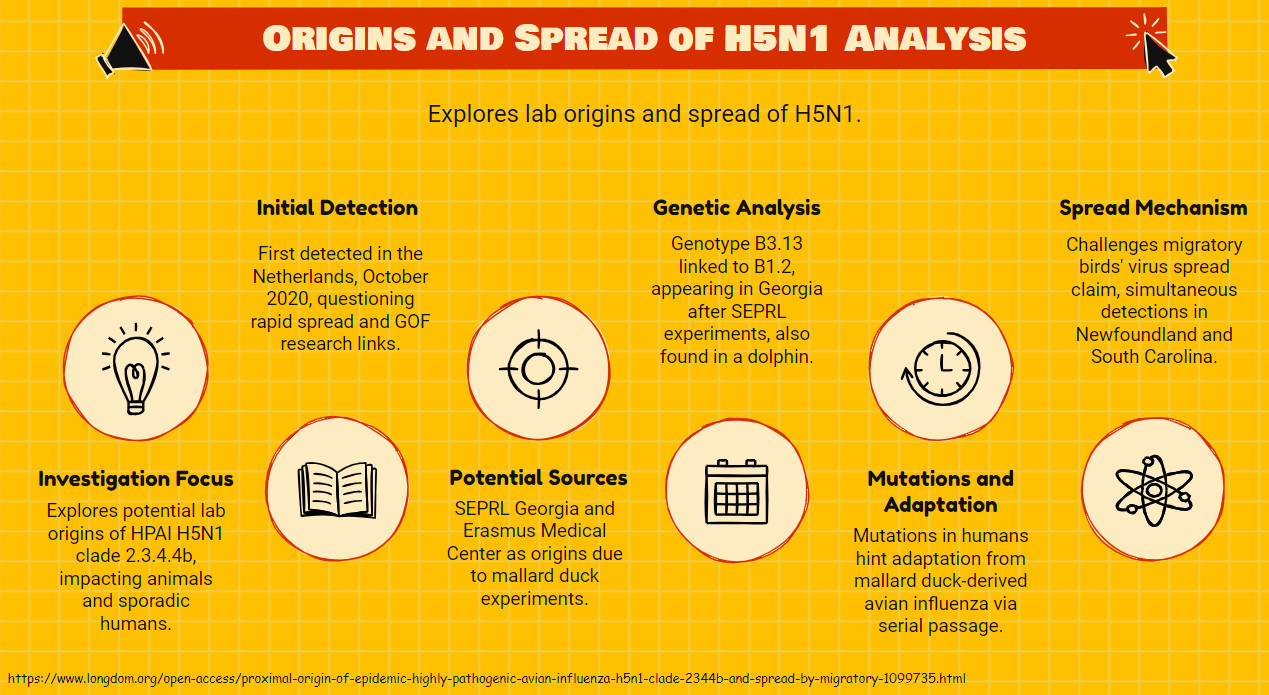Peer-Reviewed Study H5N1 Bird Flu May Have Leaked from USDA
"Proximal Origin of Epidemic Highly Pathogenic Avian Influenza H5N1 Clade 2.3.4.4b and Spread by Migratory Waterfowl" investigates the potential laboratory origins of the Highly Pathogenic Avian Influenza (HPAI) H5N1 clade 2.3.4.4b, genotype B3.13, first detected in the Netherlands in October 2020 and now affecting various species, including sporadic human infections. It points to the USDA Southeast Poultry Research Laboratory (SEPRL) in Georgia and the Erasmus Medical Center in Rotterdam as possible sources, citing their serial passage experiments with H5Nx viruses in mallard ducks. The emergence of genotype B1.2 in Georgia in January 2022, shortly after SEPRL experiments began in April 2021, and its detection in a Florida dolphin in March 2022, alongside genotype B3.13 in 2024, suggest a genetic link. Specific mutations (e.g., PB2 E627K, PB2 M631L) in human cases indicate adaptation possibly tied to these experiments, with the NP gene likely derived from mallard duck influenza.
There are questions in the narrative of migratory birds spreading the virus across the North Atlantic, noting near-simultaneous detections in Newfoundland and South Carolina (near SEPRL) in December 2021, and challenges the unprecedented nature of such a spread. It calls for a deeper investigation into potential laboratory leaks involving mallard ducks and migratory waterfowl, which may have seeded infections in poultry and livestock worldwide, though causation remains unproven. Highlighting the risks of gain-of-function (GOF) research, the authors recommend a moratorium on serial passage experiments with H5N1 to avert a potential man-made influenza pandemic that could impact both animal and human populations globally.

"Proximal Origin of Epidemic Highly Pathogenic Avian Influenza H5N1 Clade 2.3.4.4b and Spread by Migratory Waterfowl" from Longdom Publishing:
Investigation Focus: The article explores potential laboratory origins of the Highly Pathogenic Avian Influenza (HPAI) H5N1 clade 2.3.4.4b, genotype B3.13, which is currently impacting various animal species and causing sporadic human infections.
Initial Detection: HPAI H5N1 clade 2.3.4.4b was first detected in the Netherlands in October 2020, raising questions about its rapid spread and possible links to prior gain-of-function (GOF) research.
Potential Sources: The study suggests that the USDA Southeast Poultry Research Laboratory (SEPRL) in Athens, Georgia, and the Erasmus Medical Center in Rotterdam, Netherlands, may be the proximal origins due to their serial passage experiments with H5Nx viruses in mallard ducks.
Genetic Analysis: Genotype B3.13, emerging in 2024, is genetically linked to genotype B1.2, which appeared in Georgia in January 2022 following SEPRL experiments begun in April 2021. Genotype B1.2 was also found in a bottlenose dolphin in Florida in March 2022.
Mutations and Adaptation: Notable mutations (e.g., PB2 E627K, PB2 M631L) in human cases suggest adaptation possibly linked to serial passage experiments, with the NP gene likely originating from mallard duck-derived avian influenza. Spread Mechanism: The article challenges the unprecedented claim of migratory birds spreading the virus from Europe to North America across the North Atlantic, noting simultaneous detections in Newfoundland and South Carolina (near SEPRL) in December 2021.
Call for Investigation: It urges further investigation into potential H5N1 laboratory leaks, focusing on mallard ducks and migratory waterfowl, which could infect poultry and livestock globally, emphasizing that causation is not yet established. Policy Recommendation: The authors advocate for a moratorium on GOF research, including serial passage of H5N1, to prevent a possible man-made influenza pandemic affecting both animals and humans.
Dig In longdom.org TheFocalPoints.com
